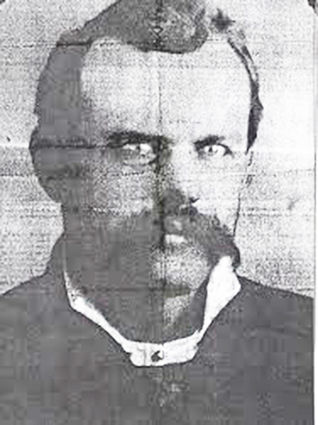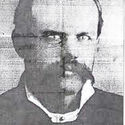The Frank Finkel Story
Many facts in evidence suggest Frank Finkel's story is true...but questions remain unanswered
April 16, 2020

-Submitted photo
This map depicts the routes Lt. Col. George Custer and his Seventh Cavalry, along with other companies, are believed to have traveled in the Battle of the Little Bighorn.
By Gary Lentz
Retired Ranger
Lewis and Clark Trail State Park
Special to the Dayton Chronicle
–Continued from the April 9, 2020, this installment of Gary Lentz's informative program at the Blue Mountain Heritage Society's fundraiser in February.
From last week: Custer's companies rode "blooded horses," meaning Company C (Custer's men) were on sorrel roan horses. Crow Scout Curley said he saw a trooper on a grey horse galloping north during the battle, however, on a grey horse. That day, the alkaline dust made all horses grey.
People saw the remains of a scar on Frank Finkel's forehead. People who knew him and talked about him here in Dayton said that he did: he had a scar on the forehead.
And he walked with a small limp. Which would be true if he had been shot...grazed in the ankle.
If you believe some of the stories that were written long after his death, he goes through a long period of time where the trapper took pitch and melted it down, and put it on the wound, and all kinds of stuff...but we know what Finkel said, that he was shot in the foot and he walked with a limp after that.

His first wife said he carried a bullet as a good luck charm, and had a scar on his abdomen. In fact, when she first knew him, the bullet was still there. He didn't want anybody to fool with it; he didn't want a doctor to take it out; he didn't want anything.
Eventually, it worked its way out, or it came out somehow, and after it came out, he carried it in his vest pocket as a souvenir.
Finkel said he placed a bullet on a window sill that he had been working on, and it fell down between the inside and outside walls of the house he was building. Could it still be there? Maybe.

As for enlistment papers, we found some, but are they his? This is subject to conjecture. "It looks like Finkel, but we can't be sure. Besides, he said his name was Frank Hall."
One of the oddest things of all is the fact that there was a man named August Finckel in Company C. He was a sergeant, and was killed in the battle.
When asked if that could be him, Finkel replied: "I was a private. I sometimes had corporal duties, but was never a sergeant."
It would've been so easy for Finkel to say "yeah, I'm that guy, and they misidentified me and I'm dead over on the battlefield."
But he didn't. He stuck with what he knew, and he told you what the truth was.
To make it even more confusing, it's unlikely that his closest friends would've known Frank Finkel by that name. He had enlisted under the name "Frank Hall." Again, to remain true to what he knew.
Survivor Charles A. Windolph was in the Reno-Benteen group and said he was friends with Sgt. Finckle, and, knew him well and after the battle, Finckel's body couldn't be found. Maybe he got away but when Windolph was told that Finkel was still alive, he didn't believe that either.
So there's some confusion whether he had the right Finkel or not, Lentz said. He may have had somebody else. There is a confusion there.
What was his name? Frank S. Finkel.
Milton Kosch, Gordon Bateman and I went to the Dayton Cemetery to visit Finkel's grave, and I asked them what was Frank's middle name? He said "well, that isn't right. They put an 's' there, but they shouldn't have done that.
"We wrote out what we wanted them to put on the grave," Kosch said, "they wrote in cursive, and he his real name should have been Frank A. Finkel, not Frank S. Finkel.
The "a" stands for August, Lentz said. "Just that much more confusing."
When asked about General Custer, his answer was: 'As a private, I didn't spend much time with the general.' It's a beautiful answer; just what you'd expect from a private.
Of those 69 others who said they were survivors, they all went into long, glowing details about Custer because that's what they knew people wanted to hear.
If you were selling newspapers, you were going to tell them what they wanted to know so they would pay you to tell your story. Finkel never did that. He just said 'I was a private and I didn't hang out with the general.'
Perhaps somewhere there is definite proof to validate Finkels story: maybe the captain's log of the steam boat he was on; perhaps papers that haven't been discovered yet.
The sad thing to say is we may never be sure, although the story is not yet finished, Lentz said.
In 1985, they did that excavation over in the coulee deep ravine. They found arm bones. They're still finding artifacts. Not very long ago, they found wrist and hand bones from a trooper out on Reno-Benteen Hill.
Down in the brush that was on the hillsides, it's probable that more will be discovered, especially if there is a fire. The day they have a fire, you can bet they'll be out there doing the archeology. Who knows what they're liable to find in that particular area.
There's one other theory: I can't back this up with any more facts than what we have.
What if Finkel was the trapper himself who found a wounded soldier and cared for him?
Switch roles here: Finkel's the trapper, not the trooper. In the process, he was told of the battle by the trooper. The man was sick and dying, and yet he could tell Finkel what he knew of the battle and Finkel, the trapper, would've listened.
When the man died...Finkel said the trapper died of his wounds, Frank Finkel buried him in Montana near his cabin. The man is dead; Finkel is alone. He decides he's had enough of the lonely life of trapping.
He heads up to Fort Benton, he makes some money, and from there, he moves over to Dayton.
When the movie came out in 1912, it wasn't quite right, and after all those years, he told the trooper's story as though it was his own story.
There may be other circumstances, such as being a deserter from the Army, and hiding out as a trapper before the battle, perhaps changing names to avoid detection; perhaps just getting into human nature to tell a good story. We can never know for certain.
Just keep in the back of your minds that there is that possibility, and it fits all the facts, just like the rest of it.
Everybody at the Blue Mountain Heritage Society event asked me if Frank Finkel was really a Custer's Last Stand survivor. I'm inclined to believe his story, for these reasons:
-He told it in a forthright manner. He didn't embellish it. He didn't say 'I was a hero. I did this, I did that' like most of the others did.
-He passed up opportunities to validate it. 'I didn't ride a grey horse, I rode a chestnut roan.' Or 'I didn't act as a sergeant, I was never a sergeant.' He just stated the facts.
-He had injuries comparable to his story. We know that he had the wounds that he got.
-He didn't seek any profit or notoriety from it. Does anyone know the wealth of Frank Finkel? He was a wealthy man. He could have been wealthy beyond belief if he could've established that that was really him as a survivor of the Battle of the Little Bighorn. And he could've established that by lying at any one of those points. And he didn't.
So, I'm inclined to believe him.
Over the years–I know some of you are Custer fans–as I am. You've got Remington's drawing' you've got 'They Died with Their Boots On,' you've got 'Little Big Man.'
Attitudes toward George A. Custer have changed over the years. Some look at him and say 'oh, he was a buffoon. He was crazy.' He was actually a Civil War general of great renown.
Like with Custer, our point of view changes with time. I'm hoping it does with Finkel, too.
That as we go on, we learn more facts that are written; questions are asked and answered, eventually we'll come up with that.
Sometimes the more we learn, the more we realize what we don't know, and Frank Finkel's story is just like that.
Frank Finkel chooses to spend the rest of his life here in southeast Washington. His story belongs to us, regardless of whether or not it is ever proven, or disproven, it is now a fascinating part of your history.
He is from here; he told that story, and there are elements that give us pause to believe. And then just let it run.




